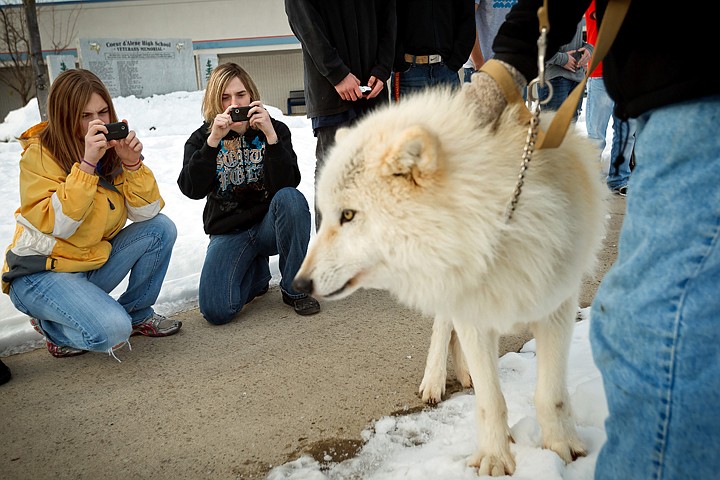High school students weigh in on wolf debate
COEUR d'ALENE - A timberwolf paid a visit to Viking territory Tuesday, but it was no sporting event.
Students in Robbyn Thomas' environmental science classes at Coeur d'Alene High School got to spend some time with Mohawk, a male member of the wolf pack that resides with the folks at Wolf People, a Bonner County organization that aims to educate people about wolves.
The fluffy, cream-colored animal, 80 percent Arctic wolf and 20 percent timberwolf, paced back and forth on a sidewalk outside the high school on the end of a leash held by handler Mike Marzio. The students stood about 20 feet away from the animal, separated by a field of snow.
"This is the first time they have seen a wolf," Thomas said.
Back in the classroom, the students heard from Mike Kincaid of Hayden Lake, a retired Alaska State Trooper who, in his law enforcement position, tracked wildlife for Alaska's fish and game patrol.
Kincaid provided facts about wolves. They weigh 60-110 pounds with a lifespan of 13 years. He also talked about what they eat.
"They're not vegetarians, and they don't eat little mice," Kincaid said.
He showed the students images of wolves bringing down a moose, and circling a bison, and told them that wolves eat a significant amount of moose and elk.
Kincaid also challenged the students to decide for themselves whether wolves are "cute and cuddly" or "killers," by showing them pictures of fuzzy, young wolf pups and grown animals looking relaxed and content.
He countered those images by showing slides with wolves baring their teeth and being menacing and aggressive. He showed an image of a horse carcass, much of its skeleton laying nearby on the ground.
"That's what happens if a wolf gets near your horse," he said.
Kincaid told students that until earlier this year, there hadn't been a documented fatal wolf attack in the United States since 1909. A school teacher was killed in March while jogging on a snow machine trail outside an Alaska Peninsula village.
There have been far more documented fatal wolf attacks in Eurasia, he said.
"If you're out in the wilderness and you see a wolf, run," Kincaid told students.
The visits were part of a special project in which Thomas' classes are investigating the heavily debated topic of wolves in Idaho from several different viewpoints.
"We have been following the recent articles in the Coeur d'Alene Press with regard to the endangered species act and the road map sought for wolves," Thomas said.
Tuesday's visits from a wolf tracker and a wolf handler provided, Thomas said, "a learning platform that may increase the students' appreciation for wildlife, diversity, and conservation but at the same time allow them to form their own opinions and views on the topic of listing or delisting the wolf."
Wolves were stripped of their endangered status protection in Idaho in 2009, and one managed wolf hunting season followed. The animals were returned to the endangered list earlier this year following a lawsuit from environmentalists, shutting down the opportunity for another wolf hunt.
"I kind of think they should have kept it open," said Jackson Hern, 16.
Doug Barnes, another one of Thomas' students, said he also thinks it's OK to control wolf populations with managed hunts. It needs to be done minimally, though, with public safety as the main objective.
"That would be bad if you had a wolf show up at your son's soccer game or something," he said.

